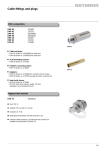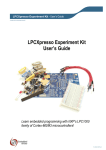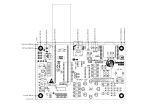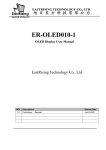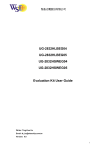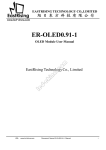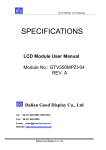Download UG-2896GDEAF11 EVK user guide v1.0 - data
Transcript
悠景科技股份有限公司 UG-2896GDEAF11 Application note Evaluation Kit User Guide Writer: Sean. Lai Email: [email protected] Version: Preliminary 1 悠景科技股份有限公司 Contents 1. REVISION HISTORY……………………………………………………………………………...3 2. EVK Schematic……………………………………………………………………………………..4 3. Symbol define………………………………………………………………………………………5 4. TIMMING CHARACTERISTICS…………………………...……………………………………...7 4.1 6800-Series MPU parallel Interface …………………………………...………………..7 4.2 8080-Series MPU parallel Interface …………………………………………………….8 4.3 4-bitSPI Interface ………………………...………………………………………………..9 4.4 3-bitSPI Interface ………...………………………………………………………………10 5. EVK use introduction………………………………………………………………………..…..11 6. Power down and Power up Sequence………………………………………………………..13 7. How to use SSD1351 module………………………………………………………………......14 7.1 Initial Step Flow…………………………………………………………………………...14 7.2 RD recommend Initial Code for 80 Interface…………………………………………15 7.2.1 Sub Function for 80 Interface………………………………………………….17 2 悠景科技股份有限公司 1. REVISION HISTORY Date Page Contents Version 2008/10/06 * Preliminary Preliminary 1.0 3 悠景科技股份有限公司 2. Schematic 2.1 EVK Schematic 4 悠景科技股份有限公司 3. Symbol define D0-D7:These pins are bi-directional data bus connecting to the MCU data bus. For SPI application, D[0]=SCLK & D[1]=SDIN. Unused pins are recommended to tie LOW except D[2]. BS0,BS1,BS2,BS3:MCU bus interface selection pins. Select appropriate logic setting as described in the following table. BS3 and BS2 are command programmable (by command ABh).[reset = 00]. BS1 and BS0 are pin select(J3, J4). Regarding to the application of BS3 and BS2, they should be fixed as 00. Table 1 – MCU Interface Selection Setting E (RD#):This pin is MCU interface input. When 6800 interface mode is selected, this pin will be used as the Enable (E) signal. Read/write operation is initiated when this pin is pulled HIGH and the chip is selected. When 8080 interface mode is selected, this pin receives the Read (RD#) signal. Read operation is initiated when this pin is pulled LOW and the chip is selected. When serial interface is selected, this pin E(RD#) must be connected to VSS. R/W#:This pin is read / write control input pin connecting to the MCU interface. When 6800 interface mode is selected, this pin will be used as Read/Write (R/W#) selection input. Read mode will be carried out when this pin is pulled HIGH and write mode when LOW. When 8080 interface mode is selected, this pin will be the Write (WR#) input. Data write operation is initiated when this pin is pulled LOW and the chip is selected. When serial interface is selected, this pin R/W (WR#) must be connected to VSS. D/C#:This pin is Data/Command control pin connecting to the MCU. When the pin is pulled HIGH, the data at D[7:0] will be interpreted as data. 5 悠景科技股份有限公司 When the pin is pulled LOW, the data at D[7:0] will be interpreted as command. 4-Wire SPI Interface D/C pin Data/Command control pin connecting to the MCU. 3-Wire SPI Interface D/C pin Tie Low. RES#:This pin is reset signal input. When the pin is pulled LOW, initialization of the chip is executed. Keep this pin pull HIGH during normal operation. CS#:This pin is the chip select input connecting to the MCU. The chip is enabled for MCU communication only when CS# is pulled LOW. VCC:Power supply for panel driving voltage. This is also the most positive power voltage supply pin. It is supplied by external high voltage source. VCI:Low voltage power supply GND:Power supply ground. VDDIO:Power supply for interface logic level. It should match with the MCU interface voltage level and must be connected to external source. VSL:This is segment voltage reference pin. When external VSL is not used, this pin should be left open. When external VSL is used, connect with resistor and diode to ground. (details depend on application) VCOMH:COM signal deselected voltage level. A capacitor should be connected between this pin and VSS. GPIO0: Detail refer to Command B5h GPIO1: Detail refer to Command B5h 6 悠景科技股份有限公司 4. TIMMING CHARACTERISTICS 4.1 6800-Series MPU parallel Interface Figure 1 6800-series MCU parallel interface characteristics Table 2 6800-Series MCU Parallel Interface Timing Characteristics 7 悠景科技股份有限公司 4.2 8080-Series MPU parallel Interface Figure 2 8080-Series MCU Parallel Interface Timing Characteristics Table 3 8080-Series MPU parallel Interface Timing Characteristics 8 悠景科技股份有限公司 4.3 4-Wire SPI Interface Figure 3 Serial interface characteristics (4-wire SPI) Table 4 Serial Interface Timing Characteristics (4-wire SPI) 9 悠景科技股份有限公司 4.4 3- Wire SPI Interface Figure 4 Serial interface characteristics (3-wire SPI) Table 5 Serial Interface Timing Characteristics (3-wire SPI) 10 悠景科技股份有限公司 5. EVK use introduction Figure 5 EVK PCB and OLED Module Push here to lock module 11 悠景科技股份有限公司 Figure 6 The combination of the module and EVK Because the package of UG-2896GDEAF11 is COF, that the connect pads are on the top of the module, and the connector which on the EVK PCB board is double size connect type. So when assemble the module with EVK. The module must face up first and plug into the connector. When finished assembled the module and EVK, then push the locking pad to lock the module. See the figure 6. When finished assembled the module and EVK. User can use leading wire to connect EVK with customer’s system. The example shows as figure 7. Note 1 Figure 7 control MCU connect with EVK Note 1:It is the external most positive voltage supply. In this sample is connected to power supply. 12 悠景科技股份有限公司 6. Power down and Power up Sequence To protect OLED panel and extend the panel life time, the driver IC power up/down routine should include a delay period between high voltage and low voltage power sources during turn on/off. Such that panel has enough time to charge up or discharge before/after operation. Power up Sequence: 1. Power up VCI and VDDIO 2. Send Display off command 3. Driver IC Initial Setting 4. Clear Screen 5. Power up VCC 6. Delay 100ms (when VCI is stable) 7. Send Display on command VCI VDDIO on VCC on Display on VCC VCI VSS/Ground Power down Sequence: 1. 2. 3. 4. Send Display off command Power down VCC Delay 100ms Power down VCI and VDDIO Display off VCC off VCI VDDIO off V CC V CI VSS/Ground 13 悠景科技股份有限公司 7. How to use SSD1351 module 7.1 Initial Step Flow Reset set RES#=0 Delay 100ms RES#=1 Initial IC Clear RAM Display on Start send data 14 悠景科技股份有限公司 7.2 RD recommend Initial Code for 8080 Interface write_c(0xfd); // Set Command Lock write_d(0xb1); write_c(0xae); // Display off write_c(0x15); write_d(0x00); write_d(0x7f); //set column write_c(0x75); write_d(0x00); write_d(0x5f); //set row write_c(0xa0); write_d(0x74); // Set Re-map / Color Depth write_c(0xa1); write_d(0x00); // Set display start line write_c(0xa2); write_d(0x00); // Set display offset write_c(0xa6); // Normal display write_c(0xab); write_d(0x00); // Set Function selection write_c(0xaf); // Set Sleep mode write_c(0xb1); write_d(0x32); // Set pre & dis_charge write_c(0xb3); write_d(0xf1); // clock & frequency write_c(0xb4); write_d(0xa0); write_d(0xb5); write_d(0x55); // Set Segment LOW Voltage write_c(0xb5); write_d(0x0A); // Set GPIO write_c(0xb6); write_d(0x01); // Set Second Pre-charge Period write_c(0xb8); write_d(0); write_d(2); write_d(3); write_d(4); write_d(5); write_d(6); write_d(7); write_d(8); write_d(9); write_d(10); write_d(11); //Set Gray Table //0 //1 //2 //3 //4 //5 //6 //7 //8 //9 //10 15 悠景科技股份有限公司 write_d(12); write_d(13); write_d(14); write_d(15); write_d(16); write_d(17); write_d(18); write_d(19); write_d(21); write_d(23); write_d(25); write_d(27); write_d(29); write_d(31); write_d(33); write_d(35); write_d(37); write_d(39); write_d(42); write_d(45); write_d(48); write_d(51); write_d(54); write_d(57); write_d(60); write_d(63); write_d(66); write_d(69); write_d(72); write_d(76); write_d(80); write_d(84); write_d(88); write_d(92); write_d(96); write_d(100); write_d(104); write_d(108); write_d(112); write_d(116); write_d(120); write_d(125); write_d(130); write_d(135); write_d(140); write_d(145); write_d(150); write_d(155); write_d(160); write_d(165); write_d(170); write_d(175); write_d(180); //11 //12 //13 //14 //15 //16 //17 //18 //19 //20 //21 //22 //23 //24 //25 //26 //27 //28 //29 //30 //31 //32 //33 //34 //35 //36 //37 //38 //39 //40 //41 //42 //43 //44 //45 //46 //47 //48 //49 //50 //51 //52 //53 //54 //55 //56 //57 //58 //59 //60 //61 //62 //63 write_c(0xbb); write_d(0x17); // Set pre-charge voltage of color A B C write_c(0xbe); write_d(0x05); // Set VcomH 16 悠景科技股份有限公司 write_c(0xc1); write_d(0xc8); write_d(0x80); write_d(0x8a); // Set contrast current for A B C write_c(0xc7); write_d(0x0f); // Set master contrast write_c(0xca); write_d(0x5f); // Duty write_c(0xaf); // Display on 7.2.1 Sub Function for 80 Interface void write_c(unsigned char out_command) { DC=0; CS=0; RW=0; P1=out_command; RW=1; CS=1; DC=1; } void write_d(unsigned char out_data) { DC=1; CS=0; RW=0; P1=out_data; RW=1; CS=1; DC=0; } Note:1.For 80 series CPU interface. 2.For 8 Bbit Ttiple Transfer 65K support. 17


















